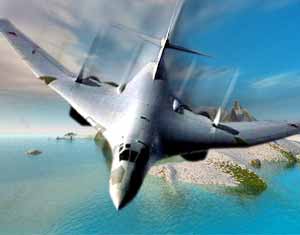08.06.2009
June 2, 2009 (the date of publication in Russian)
Maxim Kalashnikov
X-32 FACTOR: LONG-RANGE ASYMMETRY
Russia should think about a preventive move in the Arctic stand – the cruise missiles
 Aggravation of the Arctic situation is visible even with a naked eye. Unfortunately, Russia faces these new circumstances with a significantly weaker Northern fleet, comparing with the times of the Soviet Union. How to catch up with this lag? Our chances to catch up with the West in the navy means are poor in the short and medium perspective. Why not to choose another way and to make a strong and unexpected move in an arms policy? For example, give the second birth to the fleet of our strategic long-range missile carriers Tu-160. We can equip them with a new long-range anti-ship missile X32. This may become our asymmetrical answer to the dominance of NATO in the aircraft carriers navy.
Aggravation of the Arctic situation is visible even with a naked eye. Unfortunately, Russia faces these new circumstances with a significantly weaker Northern fleet, comparing with the times of the Soviet Union. How to catch up with this lag? Our chances to catch up with the West in the navy means are poor in the short and medium perspective. Why not to choose another way and to make a strong and unexpected move in an arms policy? For example, give the second birth to the fleet of our strategic long-range missile carriers Tu-160. We can equip them with a new long-range anti-ship missile X32. This may become our asymmetrical answer to the dominance of NATO in the aircraft carriers navy.
As far back as 1980s Raduga design bureau, while looking for a substitute for the X-22 anti-ship missile (the main armament of USSR military air forces against the U.S. aircraft carriers), started the development of a new anti-ship missile X-32. What was the problem? The old missile had one big disadvantage – its range was just about 360–380 km. It meant the distance to the horizon or a visibility distance from a plane flying on a high altitude. It was practically impossible to launch X-22 over the horizon: "head" of the missile wasn't able to find the target. Thus in a real fight our supersonic missile carriers Tu-22M3 had to break through the fighter's escort of enemy's squadron from the distance of 800 km, which meant huge losses.
That's how X-32 missile was created. If X-22, which is still in service, after the launch gains the altitude of 22,000 m and speeds up to 3600 km per hour, X-32, after detachment from the plane, soars upwards practically to the near space, reaching the altitude of 40 kilometers. There it "looks over the horizon", discovering the targets that can be as far as 600 km (or even 1000 km). Warhead of this missile is far more "smarter" than the one of X-22 — it can pick up the most important target (aircraft carrier or cruiser) by itself. It speeds up to 6–7 M and it's mostly impossible to intercept.
The tests of X-32 were successful even in the end of 90s. Long-range aviation was cooperating with the navy: they were willingly giving their old tubs for these tests. So what's happened? In the beginning of 2000s everything stopped! X-32 still hasn't gone into service.
Isn't it time to change the situation? Why not to counterbalance the navy power of the USA and NATO with our air forces? We have to do it now, until Russia hasn't finally lost ability to produce heavy supersonic missile carriers like Tu-160, which can operate far over the Atlantic, the Arctic and the Pacific Ocean. Tu-160 with the support of aerial tankers can function on a global scale, and its speed is 20-30 times higher than the speed of the fastest ship.
As for now, Tu-160s are designed to carry strategic cruise missiles X-55, X-555 and X-101 (after modernization). All of them are designed to attack the surface targets deep into the enemy's territory. But we also can create the navy modification of this aircraft, carrying the X-32 missiles, some kind of an air cruiser.
Such air fleet wouldn't be out of place in the matter of assertion of Russian interests in the Arctic.
Number of shows: 4274
rating:
3.45
 ENG
ENG 

 ENG
ENG 
